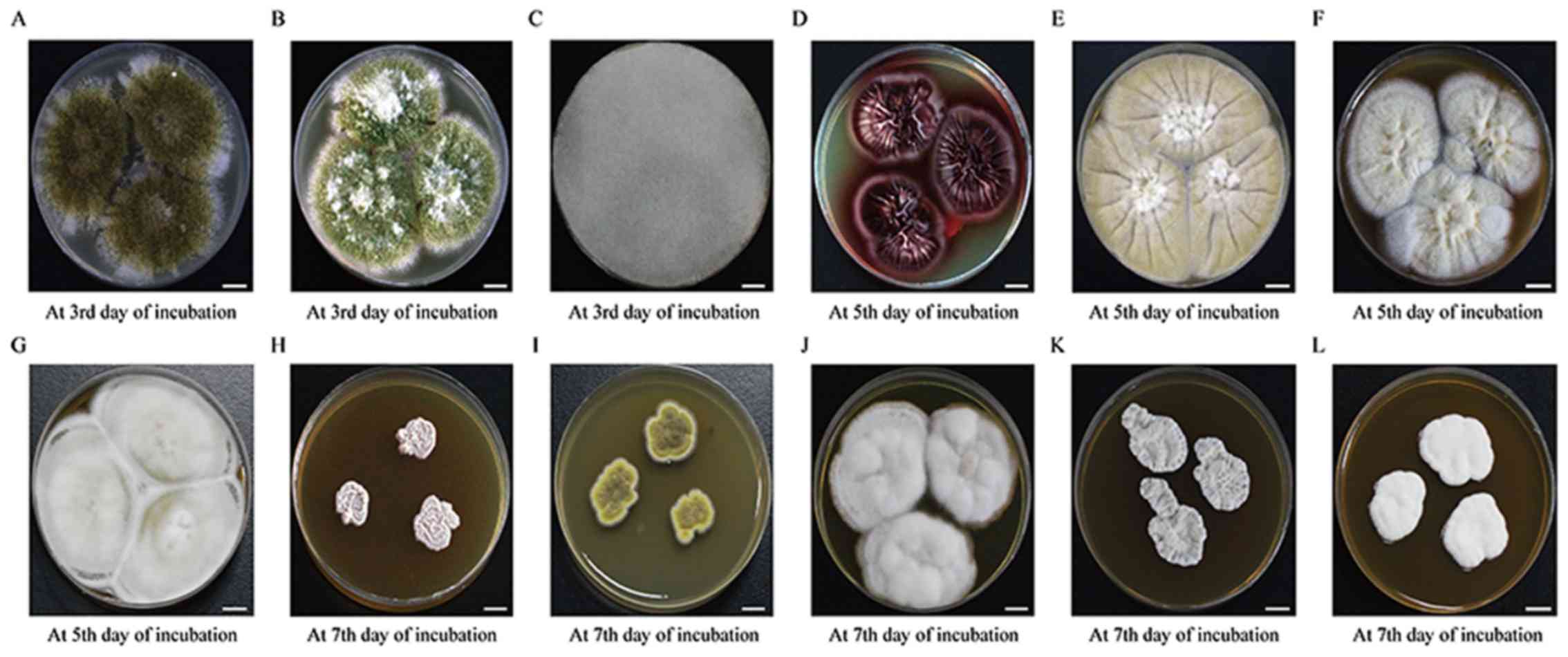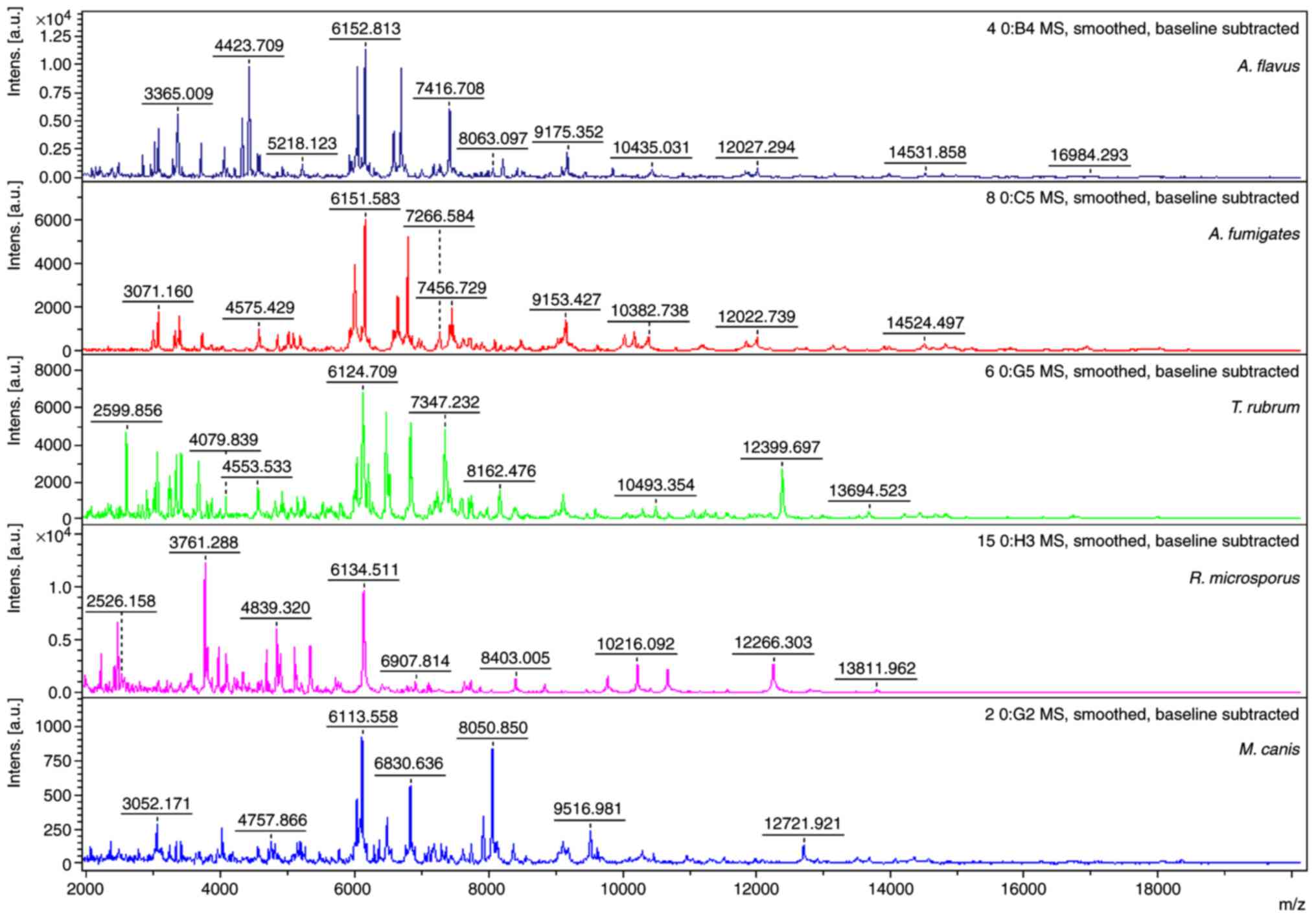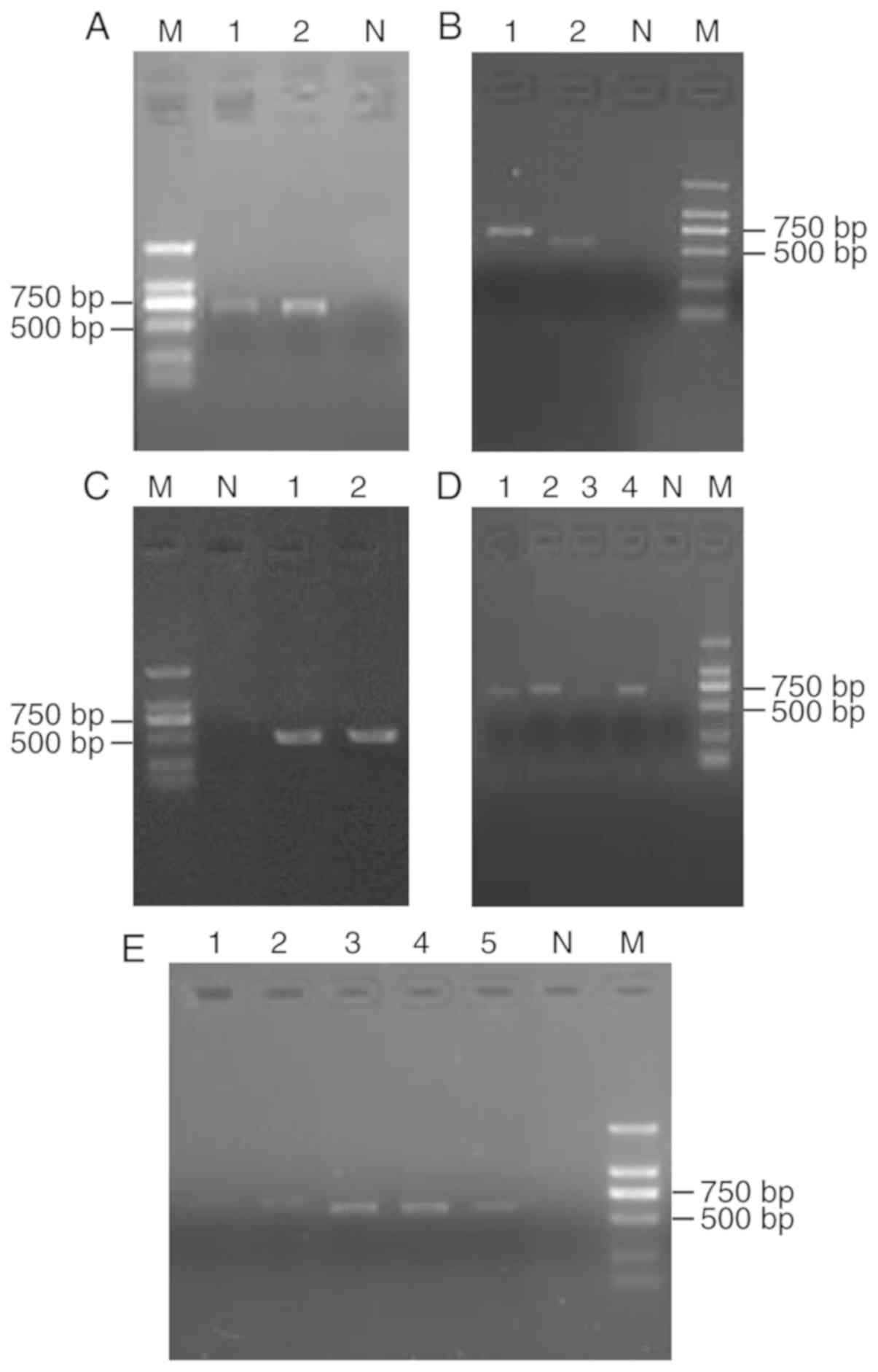|
1
|
Kontoyiannis DP, Marr KA, Park BJ,
Alexander BD, Anaissie EJ, Walsh TJ, Ito J, Andes DR, Baddley JW,
Brown JM, et al: Prospective surveillance for invasive fungal
infections in hematopoietic stem cell transplant recipients,
2001–2006: Overview of the Transplant-Associated Infection
Surveillance Network (TRANSNET) Database. Clin Infect Dis.
50:1091–1100. 2010. View
Article : Google Scholar : PubMed/NCBI
|
|
2
|
Alcazar-Fuoli L, Mellado E,
Alastruey-Izquierdo A, Cuenca-Estrella M and Rodriguez-Tudela JL:
Aspergillus section Fumigati: Antifungal
susceptibility patterns and sequence-based identification.
Antimicrob Agents Chemother. 52:1244–1251. 2008. View Article : Google Scholar : PubMed/NCBI
|
|
3
|
Grumbt M, Monod M and Staib P: Genetic
advances in dermatophytes. FEMS Microbiol Lett. 320:79–86. 2011.
View Article : Google Scholar : PubMed/NCBI
|
|
4
|
de Respinis S, Tonolla M, Pranghofer S,
Petrini L, Petrini O and Bosshard PP: Identification of
dermatophytes by matrix-assisted laser desorption/ionization
time-of-flight mass spectrometry. Med Mycol. 51:514–521. 2013.
View Article : Google Scholar : PubMed/NCBI
|
|
5
|
Abastabar M, Mirhendi H,
Rezaei-Matehkolaei A, Shidfar MR, Kordbacheh P and Makimura K:
Restriction analysis of β-tubulin gene for differentiation of the
common pathogenic dermatophytes. J Clin Lab Anal. 28:91–96. 2014.
View Article : Google Scholar : PubMed/NCBI
|
|
6
|
Cafarchia C, Iatta R, Latrofa MS, Gräser Y
and Otranto D: Molecular epidemiology, phylogeny and evolution of
dermatophytes. Infect Genet Evol. 20:336–351. 2013. View Article : Google Scholar : PubMed/NCBI
|
|
7
|
Marimon R, Cano J, Gené J, Sutton DA,
Kawasaki M and Guarro J: Sporothrix brasiliensis, S.
globosa, and S. mexicana, three new Sporothrix
species of clinical interest. J Clin Microbiol. 45:3198–3206. 2007.
View Article : Google Scholar : PubMed/NCBI
|
|
8
|
Nenoff P, Herrmann J and Gräser Y:
Trichophyton mentagrophytes sive interdigitale? A dermatophyte in
the course of time. J Dtsch Dermatol Ges. 5:198–202. 2007.
View Article : Google Scholar : PubMed/NCBI
|
|
9
|
Gräser Y, Scott J and Summerbell R: The
new species concept in dermatophytes-a polyphasic approach.
Mycopathologia. 166:239–256. 2008. View Article : Google Scholar : PubMed/NCBI
|
|
10
|
Drogari-Apiranthitou M, Mantopoulou FD,
Skiada A, Kanioura L, Grammatikou M, Vrioni G, Mitroussia-Ziouva A,
Tsakris A and Petrikkos G: In vitro antifungal susceptibility of
filamentous fungi causing rare infections: Synergy testing of
amphotericin B, posaconazole and anidulafungin in pairs. J
Antimicrob Chemother. 67:1937–1940. 2012. View Article : Google Scholar : PubMed/NCBI
|
|
11
|
Liu J, Yu Y, Cai Z, Bartlam M and Wang Y:
Comparison of ITS and 18S rDNA for estimating fungal diversity
using PCR-DGGE. World J Microbiol Biotechnol. 31:1387–1395. 2015.
View Article : Google Scholar : PubMed/NCBI
|
|
12
|
Chen JH, Yam WC, Ngan AH, Fung AM, Woo WL,
Yan MK, Choi GK, Ho PL, Cheng VC and Yuen KY: Advantages of using
matrix-assisted laser desorption ionization-time of flight mass
spectrometry as a rapid diagnostic tool for identification of
yeasts and mycobacteria in the clinical microbiological laboratory.
J Clin Microbiol. 51:3981–3987. 2013. View Article : Google Scholar : PubMed/NCBI
|
|
13
|
Del Chierico F, Masotti A, Onori M,
Fiscarelli E, Mancinelli L, Ricciotti G, Alghisi F, Dimiziani L,
Manetti C, Urbani A, et al: MALDI-TOF MS proteomic phenotyping of
filamentous and other fungi from clinical origin. J Proteomics.
75:3314–3330. 2012. View Article : Google Scholar : PubMed/NCBI
|
|
14
|
Triest D, Stubbe D, De Cremer K, Piérard
D, Normand AC, Piarroux R, Detandt M and Hendrickx M: Use of
matrix-assisted laser desorption ionization-time of flight mass
spectrometry for identification of molds of the Fusarium genus. J
Clin Microbiol. 53:465–476. 2015. View Article : Google Scholar : PubMed/NCBI
|
|
15
|
Ling H, Yuan Z, Shen J, Wang Z and Xu Y:
Accuracy of matrix-assisted laser desorption ionization-time of
flight mass spectrometry for identification of clinical pathogenic
fungi: A meta-analysis. J Clin Microbiol. 52:2573–2582. 2014.
View Article : Google Scholar : PubMed/NCBI
|
|
16
|
Chao QT, Lee TF, Teng SH, Peng LY, Chen
PH, Teng LJ and Hsueh PR: Comparison of the accuracy of two
conventional phenotypic methods and two MALDI-TOF MS systems with
that of DNA sequencing analysis for correctly identifying
clinically encountered yeasts. PLoS One. 9:e1093762014. View Article : Google Scholar : PubMed/NCBI
|
|
17
|
Bille E, Dauphin B, Leto J, Bougnoux ME,
Beretti JL, Lotz A, Suarez S, Meyer J, Join-Lambert O, Descamps P,
et al: MALDI-TOF MS Andromas strategy for the routine
identification of bacteria, mycobacteria, yeasts,
Aspergillus spp. and positive blood cultures. Clin Microbiol
Infect. 18:1117–1125. 2012. View Article : Google Scholar : PubMed/NCBI
|
|
18
|
Shokohi T, Aslani N, Ahangarkani F,
Meyabadi MF, Hagen F, Meis JF, Boekhout T, Kolecka A and Badali H:
Candida infanticola and Candida spencermartinsiae
yeasts: Possible emerging species in cancer patients. Microb
Pathog. 115:353–357. 2018. View Article : Google Scholar : PubMed/NCBI
|
|
19
|
Aslani N, Janbabaei G, Abastabar M, Meis
JF, Babaeian M, Khodavaisy S, Boekhout T and Badali H:
Identification of uncommon oral yeasts from cancer patients by
MALDI-TOF mass spectrometry. BMC Infect Dis. 18:242018. View Article : Google Scholar : PubMed/NCBI
|
|
20
|
Ranque S, Normand AC, Cassagne C, Murat
JB, Bourgeois N, Dalle F, Gari-Toussaint M, Fourquet P, Hendrickx M
and Piarroux R: MALDI-TOF mass spectrometry identification of
filamentous fungi in the clinical laboratory. Mycoses. 57:135–140.
2014. View Article : Google Scholar : PubMed/NCBI
|
|
21
|
Normand AC, Cassagne C, Ranque S,
L'ollivier C, Fourquet P, Roesems S, Hendrickx M and Piarroux R:
Assessment of various parameters to improve MALDI-TOF MS reference
spectra libraries constructed for the routine identification of
filamentous fungi. BMC Microbiol. 13:762013. View Article : Google Scholar : PubMed/NCBI
|
|
22
|
Lau AF, Drake SK, Calhoun LB, Henderson CM
and Zelazny AM: Development of a clinically comprehensive database
and a simple procedure for identification of molds from solid media
by matrix-assisted laser desorption ionization-time of flight mass
spectrometry. J Clin Microbiol. 51:828–834. 2013. View Article : Google Scholar : PubMed/NCBI
|
|
23
|
Bader O, Weig M, Taverne-Ghadwal L, Lugert
R, Gross U and Kuhns M: Improved clinical laboratory identification
of human pathogenic yeasts by matrix-assisted laser desorption
ionization time-of-flight mass spectrometry. Clin Microbiol Infect.
17:1359–1365. 2011. View Article : Google Scholar : PubMed/NCBI
|
|
24
|
Yonetani S, Ohnishi H, Ohkusu K, Matsumoto
T and Watanabe T: Direct identification of microorganisms from
positive blood cultures by MALDI-TOF MS using an in-house saponin
method. Int J Infect Dis. 52:37–4. 2016. View Article : Google Scholar : PubMed/NCBI
|
|
25
|
Clinical and Laboratory Standards
Institute (CLSI), . Reference Method for Broth Dilution Antifungal
Susceptibility Testing of Filamentous Fungi; Approved standard.
(2nd). Clinical and Laboratory Standards Institute. (Wayne, PA).
M38–A2. 2008.
|
|
26
|
Cassagne C, Ranque S, Normand AC, Fourquet
P, Thiebault S, Planard C, Hendrickx M and Piarroux R: Mould
routine identification in the clinical laboratory by
matrix-assisted laser desorption ionization time-of-flight mass
spectrometry. PLoS One. 6:e284252011. View Article : Google Scholar : PubMed/NCBI
|
|
27
|
McMullen AR, Wallace MA, Pincus DH, Wilkey
K and Burnham CA: Evaluation of the Vitek MS matrix-assisted laser
desorption ionization-time of flight mass spectrometry system for
identification of clinically relevant filamentous fungi. J Clin
Microbiol. 54:2068–2073. 2016. View Article : Google Scholar : PubMed/NCBI
|
|
28
|
Normand AC, Cassagne C, Gautier M, Becker
P, Ranque S, Hendrickx M and Piarroux R: Decision criteria for
MALDI-TOF MS-based identification of filamentous fungi using
commercial and in-house reference databases. BMC Microbiol.
17:252017. View Article : Google Scholar : PubMed/NCBI
|
|
29
|
Becker PT, de Bel A, Martiny D, Ranque S,
Piarroux R, Cassagne C, Detandt M and Hendrickx M: Identification
of filamentous fungi isolates by MALDI-TOF mass spectrometry:
Clinical evaluation of an extended reference spectra library. Med
Mycol. 52:826–834. 2014. View Article : Google Scholar : PubMed/NCBI
|
|
30
|
Huang Y, Zhang M, Zhu M, Wang M, Sun Y, Gu
H, Cao J, Li X, Zhang S, Wang J, et al: Comparison of two
matrix-assisted laser desorption ionization-time of flight mass
spectrometry systems for the identification of clinical filamentous
fungi. World J Microbiol Biotechnol. 33:1422017. View Article : Google Scholar : PubMed/NCBI
|
|
31
|
Horká M, Kubesová A, Salplachta J,
Zapletalová E, Horký J and Slais K: Capillary and gel
electromigration techniques and MALDI-TOF MS - suitable tools for
identification of filamentous fungi. Anal Chim Acta. 716:155–162.
2012. View Article : Google Scholar : PubMed/NCBI
|
|
32
|
Tarumoto N, Sakai J, Kodana M, Kawamura T,
Ohno H and Maesaki S: Identification of disseminated cryptococcosis
using MALDI-TOF MS and clinical evaluation. Med Mycol J.
57:E41–E46. 2016. View Article : Google Scholar : PubMed/NCBI
|
|
33
|
Pagano L, Akova M, Dimopoulos G, Herbrecht
R, Drgona L and Blijlevens N: Risk assessment and prognostic
factors for mould-related diseases in immunocompromised patients. J
Antimicrob Chemother. 66 (Suppl 1):i5–i14. 2011. View Article : Google Scholar : PubMed/NCBI
|
|
34
|
Herbrecht R, Bories P, Moulin JC, Ledoux
MP and Letscher-Bru V: Risk stratification for invasive
aspergillosis in immunocompromised patients. Ann NY Acad Sci.
1272:23–30. 2012. View Article : Google Scholar : PubMed/NCBI
|
|
35
|
Pemán J, Cantón E, Quindós G, Eraso E,
Alcoba J, Guinea J, Merino P, Ruiz-Pérez-de-Pipaon MT,
Pérez-del-Molino L, Linares-Sicilia MJ, et al FUNGEMYCA Study
Group, : Epidemiology, species distribution and in vitro antifungal
susceptibility of fungaemia in a Spanish multicentre prospective
survey. J Antimicrob Chemother. 67:1181–1187. 2012. View Article : Google Scholar : PubMed/NCBI
|
|
36
|
Pana ZD, Farmaki E and Roilides E: Host
genetics and opportunistic fungal infections. Clin Microbiol
Infect. 20:1254–1264. 2014. View Article : Google Scholar : PubMed/NCBI
|
|
37
|
Schubert S and Kostrzewa M: MALDI-TOF MS
in the Microbiology Laboratory: Current Trends. Curr Issues Mol
Biol. 23:17–20. 2017. View Article : Google Scholar : PubMed/NCBI
|
|
38
|
De Carolis E, Posteraro B, Lass-Flörl C,
Vella A, Florio AR, Torelli R, Girmenia C, Colozza C, Tortorano AM,
Sanguinetti M, et al: Species identification of Aspergillus,
Fusarium and Mucorales with direct surface analysis by
matrix-assisted laser desorption ionization time-of-flight mass
spectrometry. Clin Microbiol Infect. 18:475–484. 2012. View Article : Google Scholar : PubMed/NCBI
|
|
39
|
Lamoth F and Alexander BD: Comparing Etest
and broth microdilution for antifungal susceptibility testing of
the most-relevant pathogenic molds. J Clin Microbiol. 53:3176–3181.
2015. View Article : Google Scholar : PubMed/NCBI
|
|
40
|
Shi JY, Xu YC, Shi Y, Lü HX, Liu Y, Zhao
WS, Chen DM, Xi LY, Zhou X, Wang H, et al: In vitro susceptibility
testing of Aspergillus spp. against voriconazole,
itraconazole, posaconazole, amphotericin B and caspofungin. Chin
Med J (Engl). 123:2706–2709. 2010.PubMed/NCBI
|
|
41
|
Heo MS, Shin JH, Choi MJ, Park YJ, Lee HS,
Koo SH, Lee WG, Kim SH, Shin MG, Suh SP, et al: Molecular
identification and amphotericin B susceptibility testing of
clinical isolates of Aspergillus from 11 hospitals in Korea. Ann
Lab Med. 35:602–610. 2015. View Article : Google Scholar : PubMed/NCBI
|
|
42
|
Vaezi A, Fakhim H, Arastehfar A, Shokohi
T, Hedayati MT, Khodavaisy S, Rezaei-Matehkolaei A, Badiee P, Hagen
F, Lass-Flörl C, et al: In vitro antifungal activity of
amphotericin B and 11 comparators against Aspergillus
terreus species complex. Mycoses. 61:134–142. 2018. View Article : Google Scholar : PubMed/NCBI
|
|
43
|
Arendrup MC, Cuenca-Estrella M, Lass-Flörl
C and Hope WW; European Committee on Antimicrobial Susceptibility
Testing Subcommittee on Antifungal Susceptibility Testing
(EUCAST-AFST), : EUCAST technical note on Aspergillus and
amphotericin B, itraconazole, and posaconazole. Clin Microbiol
Infect. 18:E248–E250. 2012. View Article : Google Scholar : PubMed/NCBI
|
|
44
|
Esquivel BD, Smith AR, Zavrel M and White
TC: Azole drug import into the pathogenic fungus Aspergillus
fumigatus. Antimicrob Agents Chemother. 59:3390–3398. 2015.
View Article : Google Scholar : PubMed/NCBI
|
|
45
|
Brilhante RS, Rodrigues AM, Sidrim JJ,
Rocha MF, Pereira SA, Gremião ID, Schubach TM and de Camargo ZP: In
vitro susceptibility of antifungal drugs against Sporothrix
brasiliensis recovered from cats with sporotrichosis in Brazil.
Med Mycol. 54:275–279. 2016. View Article : Google Scholar : PubMed/NCBI
|
|
46
|
Gheith S, Saghrouni F, Bannour W, Ben
Youssef Y, Khelif A, Normand AC, Piarroux R, Ben Said M, Njah M and
Ranque S: In vitro susceptibility to amphotericin B, itraconazole,
voriconazole, posaconazole and caspofungin of Aspergillus
spp. isolated from patients with haematological malignancies in
Tunisia. Springerplus. 3:192014. View Article : Google Scholar : PubMed/NCBI
|
|
47
|
Pinto E, Lago M, Branco L, Vale-Silva LA
and Pinheiro MD: Evaluation of Etest performed in Mueller-Hinton
agar supplemented with glucose for antifungal susceptibility
testing of clinical isolates of filamentous fungi. Mycopathologia.
177:157–166. 2014. View Article : Google Scholar : PubMed/NCBI
|

















